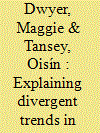| Srl | Item |
| 1 |
ID:
188330


|
|
|
|
|
| Summary/Abstract |
Since the commencement of the counterinsurgency fight against Boko Haram, the Nigerian Army has been faced with internal crises, such as corruption, poor welfare conditions for soldiers, among others, which have undermined efforts at defeating the insurgents. Military authorities have both down-played and denied these internal challenges. The result is frequent mutiny by soldiers. This paper examines the drivers, dynamics, and responses to mutiny within the Nigeria Army in the context of ongoing counterinsurgency (COIN) operation in the northeast. Anchored on the analytical framework of Tactical Communication Strategy, the paper contends that resort to mutiny is a strategy by soldiers to open up dialogue with the military authority and communicate to the public the internal factors that account for battlefield failures. Hence, the paper recommends that soldiers’ welfare be given high priority rather than resort to punitive measures.
|
|
|
|
|
|
|
|
|
|
|
|
|
|
|
|
| 2 |
ID:
177066


|
|
|
|
|
| Summary/Abstract |
Coups and mutinies have often been treated as broadly equivalent types of behavior. However, they are distinct forms of indiscipline carried out by different sets of actors and have fundamentally distinct goals. This article makes two contributions to the scholarship on both coups and mutinies. First, we offer the first systematic attempt to compare their rates and illustrate the difference in their frequency over time, drawing on data from West and Central Africa. In particular, we identify a striking divergence in the frequency of coups and mutinies over time as well as a set of fluctuations that coincide with the end of the Cold War. Second, we build a new theory to explain these divergent trends. We focus on the role of agency within the military and argue that the upheavals associated with the end of the Cold War were experienced in different ways by junior and senior ranks within armed forces. This, in turn, helps account for variation in the coup and mutiny attempts.
|
|
|
|
|
|
|
|
|
|
|
|
|
|
|
|